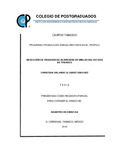| dc.contributor.author | Álvarez Sánchez, Christian Orlando | |
| dc.creator | ÁLVAREZ SÁNCHEZ, CHRISTIAN ORLANDO; | |
| dc.date.accessioned | 2020-01-22T14:27:42Z | |
| dc.date.available | 2020-01-22T14:27:42Z | |
| dc.date.issued | 2019-06 | |
| dc.identifier.uri | http://hdl.handle.net/10521/4230 | |
| dc.description | Tesis (Maestría en Ciencias, especialista en Producción Agroalimentaria en el Trópico).- Colegio de Postagraduados, 2019. | es_MX |
| dc.description.abstract | La plaga más grave para las colonias de abejas melíferas que pone en peligro la apicultura en el mundo es sin duda la Varroa destructor, aunque no existe potencial zoonótico, sí existen pérdidas económicas al reducir la población de abejas, la producción de miel y los rendimientos de muchos cultivos que dependen de la polinización de las abejas. Por ello los apicultores tratan sus colonias con acaricidas para controlar este ácaro, lo cual implica un riesgo de contaminación directa de la miel y otros productos de la colmena. La presencia de residuos de acaricidas en estos productos puede disminuir su calidad y devaluar sus propiedades, además de poner en peligro la salud humana. Debido a esto, se realizó el presente estudio para la detección de residuos de acaricidas: amitraz y cumafós (utilizados ampliamente para prevenir o detener afecciones en abejas Apis mellifera) en las mieles tabasqueñas a través del análisis por Cromatografía Líquida de Ultra Alta Resolución (UHPLC). Se analizó un total de 11 muestras de miel de las cuales se detectaron presencia de residuos de cumafós en dos muestras, y en todas, residuos de amitraz. El 81% de las muestras analizadas está libre de cumafós y podrían cumplir los requisitos para ser una miel inocua, sin embargo, amitraz está presente en todas ellas a niveles que superan los LMR de la legislación europea, mexicana y estadounidense. _______________ DETECTION OF RESIDUES OF ACARICIDES IN HONEY FROM THE STATE OF TABASCO. ABSTRACT: The most serious pest for honey bee colonies that endangers beekeeping in the world is undoubtedly the destroyer Varroa, although there is no zoonotic potential, there are economic losses to reduce the population of bees, honey production and yields of many crops that depend on the pollination of bees. Therefore beekeepers treat their colonies with acaricides to control this mite, which implies a risk of direct contamination of the honey and other products of the hive. The presence of acaricide residues in these products can reduce their quality and devalue their properties, in addition to endangering human health. Due to this, the present study was conducted for the detection of acaricide residues: amitraz and coumaphos (widely used to prevent or stop conditions in Apis mellifera bees) and thus determine the presence of possible contaminants in the Tabasco honeys through the analysis by Ultra High Resolution Liquid Chromatography (UHPLC). A total of 11 honey samples were analyzed, of which presence of coumaphos residues was detected in two samples, and in all, residues of amitraz. 81% of the analyzed samples are free of coumaphos and could meet the requirements to be an innocuous honey, however, amitraz is present in all of them at levels that exceed the MRLs of European, Mexican and American legislation. | es_MX |
| dc.description.sponsorship | Consejo Nacional de Ciencia y Tecnología (CONACyT). | es_MX |
| dc.format | pdf | es_MX |
| dc.language.iso | spa | es_MX |
| dc.rights.uri | http://creativecommons.org/licenses/by-nc-nd/4.0 | es_MX |
| dc.subject | Miel | es_MX |
| dc.subject | Acaricidas | es_MX |
| dc.subject | Amitraz | es_MX |
| dc.subject | Cumafós | es_MX |
| dc.subject | UHPLC | es_MX |
| dc.subject | Honey | es_MX |
| dc.subject | Acaricides | es_MX |
| dc.subject | Amitraz | es_MX |
| dc.subject | Coumaphos | es_MX |
| dc.subject | Producción Agroalimentaria en el Trópico | es_MX |
| dc.subject | Maestría | es_MX |
| dc.subject.classification | CIENCIAS AGROPECUARIAS Y BIOTECNOLOGÍA::CIENCIAS AGRARIAS::AGROQUÍMICA::OTRAS | es_MX |
| dc.title | Detección de residuos de acaricidas en mieles del estado de Tabasco. | es_MX |
| dc.type | Tesis | es_MX |
| Tesis.contributor.advisor | Zaldívar Cruz, Juan Manuel | |
| Tesis.contributor.advisor | Sol Sánchez, Ángel | |
| Tesis.contributor.advisor | Moscoso Ramírez, Pedro Antonio | |
| Tesis.contributor.advisor | Gabino Román, Francisco Javier | |
| Tesis.date.submitted | 2019-06 | |
| Tesis.date.accesioned | 2020 | |
| Tesis.date.available | 2020 | |
| Tesis.format.mimetype | pdf | es_MX |
| Tesis.format.extent | 1,580 KB | es_MX |
| Tesis.subject.nal | Residuos de acaricidas | es_MX |
| Tesis.subject.nal | Acaricide residues | es_MX |
| Tesis.subject.nal | Varroa destructor | es_MX |
| Tesis.subject.nal | Polinización de las abejas | es_MX |
| Tesis.subject.nal | Bee pollination | es_MX |
| Tesis.subject.nal | Apicultores | es_MX |
| Tesis.subject.nal | Beekeepers | es_MX |
| Tesis.subject.nal | Salud humana | es_MX |
| Tesis.subject.nal | Human health | es_MX |
| Tesis.subject.nal | Apis mellifera | es_MX |
| Tesis.subject.nal | H. Cárdenas, Tabasco, México | es_MX |
| Tesis.rights | Acceso abierto | es_MX |
| Articulos.subject.classification | Miel de abejas-producción | es_MX |
| dc.type.conacyt | masterThesis | es_MX |
| dc.identificator | 6||31||3101||310199 | es_MX |
| dc.contributor.director | ZALDÍVAR CRUZ, JUAN MANUEL;201358 | |
| dc.audience | generalPublic | es_MX |


